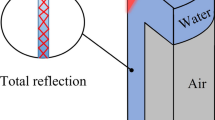Abstract
Underwater laser machining process is an alternative method to cut materials with less thermal damage due to the water cooling of workpiece during the ablation. However, the rapid cooling induced by water can instantly solidify the laser-molten material rather than expel it to form a cut. To understand the roles of processing temperature on ablation performance in water, this paper presents the influences of water temperature on cut width, depth, and surface morphology in the underwater laser grooving of silicon. The effects of laser power, laser traverse speed, and number of laser passes on the groove characteristics were also examined in this work. The results revealed that using high water temperature can increase the groove aspect ratio, particularly when high laser power, slow traverse speed, and multiple laser passes were employed. However, debris deposition and oxides were found on the laser-ablated surface when processing at high water temperature. The implication of this study could enhance the ablation rate for the underwater laser as well as low-power laser cutting systems.










Similar content being viewed by others
References
Li HN, Ge Xie K, Wu B, Zhu WQ (2019) Generation of textured diamond abrasive tools by continuous-wave CO2 laser: laser parameter effects and optimisation. J Mater Process Technol 275:116279. https://doi.org/10.1016/j.jmatprotec.2019.116279
Chavoshi SZ, Luo X (2015) Hybrid micro-machining processes: a review. Precis Eng 41:1–23. https://doi.org/10.1016/j.precisioneng.2015.03.001
Zhu H, Zhang Z, Xu K, Xu J, Zhu S, Wang A, Qi H (2018) Performance evaluation and comparison between direct and chemical-assisted picosecond laser micro-trepanning of single crystalline silicon. Materials 12(1):41
Kray D, Hopman S, Spiegel A, Richerzhagen B, Willeke GP (2007) Study on the edge isolation of industrial silicon solar cells with waterjet-guided laser. Sol Energy Mater Sol Cells 91(17):1638–1644
Karimzadeh R, Anvari JZ, Mansour N (2009) Nanosecond pulsed laser ablation of silicon in liquids. Appl Phys A 94(4):949–955
Tangwarodomnukun V, Likhitangsuwat P, Tevinpibanphan O, Dumkum C (2015) Laser ablation of titanium alloy under a thin and flowing water layer. Int J Mach Tools Manuf 89:14–28. https://doi.org/10.1016/j.ijmachtools.2014.10.013
Nguyen TTP, Tanabe-Yamagishi R, Ito Y (2019) Impact of liquid layer thickness on the dynamics of nano- to sub-microsecond phenomena of nanosecond pulsed laser ablation in liquid. Appl Surf Sci 470:250–258. https://doi.org/10.1016/j.apsusc.2018.10.160
Lv J, Dong X, Wang K, Duan W, Fan Z, Mei X (2016) Study on process and mechanism of laser drilling in water and air. Int J Adv Manuf Technol 86(5):1443–1451. https://doi.org/10.1007/s00170-015-8279-4
Ouyang P, Li P, Leksina EG, Michurin SV, He L (2016) Effect of liquid properties on laser ablation of aluminum and titanium alloys. Appl Surface Sci 360(Part B):880–888. https://doi.org/10.1016/j.apsusc.2015.11.080
Feng W, Guo J, Yan W, Wan YC, Zheng H (2019) Deep channel fabrication on copper by multi-scan underwater laser machining. Opt Laser Technol 111:653–663. https://doi.org/10.1016/j.optlastec.2018.10.046
Dowding CF, Lawrence J (2010) Excimer laser machining of bisphenol A polycarbonate under closed immersion filtered water with varying flow velocities and the effects on the etch rate. Proc Inst Mech Eng B J Eng Manuf 224(10):1469–1480. https://doi.org/10.1243/09544054jem1869
Tangwarodomnukun V, Chen HY (2015) Laser ablation of PMMA in air, water, and ethanol environments. Mater Manuf Process 30(5):685–691. https://doi.org/10.1080/10426914.2014.994774
Kim B, Iida R, Doan DH, Fushinobu K (2017) Mechanism of nanosecond laser drilling process of 4H-SiC for through substrate vias. Appl Phys A 123(6):392–399. https://doi.org/10.1007/s00339-017-0986-2
Zhang D, Gökce B, Sommer S, Streubel R, Barcikowski S (2016) Debris-free rear-side picosecond laser ablation of thin germanium wafers in water with ethanol. Appl Surf Sci 367:222–230. https://doi.org/10.1016/j.apsusc.2016.01.071
Xu JY, Hu H, Lei YL (2014) Morphological features of silicon substrate by using different frequency laser ablation in air and water. Appl Surf Sci 317:666–671. https://doi.org/10.1016/j.apsusc.2014.08.038
Tangwarodomnukun V, Dumkum C (2018) Experiment and analytical model of laser milling process in soluble oil. Int J Adv Manuf Technol 96(1):607–621. https://doi.org/10.1007/s00170-018-1648-z
Zhang H, Ren X, Luo C, Tong Y, Larson EA, Lu Z, Gu J (2019) Study on transient characteristics and influencing of temperature on cavitation bubbles in various environments. Optik 187:25–33. https://doi.org/10.1016/j.ijleo.2019.01.076
Charee W, Tangwarodomnukun V, Dumkum C (2015) Laser ablation of silicon in water under different flow rates. Int J Adv Manuf Technol 78(1):19–29. https://doi.org/10.1007/s00170-014-6625-6
Zhai Z, Wang W, Mei X, Wang K, Yang H (2017) Influence of plasma shock wave on the morphology of laser drilling in different environments. Opt Commun 390:49–56. https://doi.org/10.1016/j.optcom.2016.12.066
Tangwarodomnukun V (2016) Cavity formation and surface modeling of laser milling process under a thin-flowing water layer. Appl Surf Sci 386:51–64. https://doi.org/10.1016/j.apsusc.2016.06.011
Trtica M, Stasic J, Batani D, Benocci R, Narayanan V, Ciganovic J (2018) Laser-assisted surface modification of Ti-implant in air and water environment. Appl Surf Sci 428:669–675. https://doi.org/10.1016/j.apsusc.2017.09.185
Ye Y, Wu M, Ren X, Zhou J, Li L (2018) Hole-like surface morphologies on the stainless steel surface through laser surface texturing underwater. Appl Surf Sci 462:847–855. https://doi.org/10.1016/j.apsusc.2018.08.117
Razi S, Madanipour K, Mollabashi M (2016) Laser surface texturing of 316L stainless steel in air and water: a method for increasing hydrophilicity via direct creation of microstructures. Opt Laser Technol 80:237–246. https://doi.org/10.1016/j.optlastec.2015.12.022
Shaheen ME, Gagnon JE, Fryer BJ (2019) Studies on laser ablation of silicon using near IR picosecond and deep UV nanosecond lasers. Opt Lasers Eng 119:18–25. https://doi.org/10.1016/j.optlaseng.2019.02.003
Funding
This research was financially supported by Rajamangala University of Technology Isan (Contract No. SKC2562REV106). Authors would also like to thank the Faculty of Engineering, King Mongkut’s University of Technology Thonburi under the 2018–2019 Research Credit Fund Project.
Author information
Authors and Affiliations
Corresponding author
Additional information
Publisher’s note
Springer Nature remains neutral with regard to jurisdictional claims in published maps and institutional affiliations.
Rights and permissions
About this article
Cite this article
Charee, W., Tangwarodomnukun, V. Laser ablation of silicon in water at different temperatures. Int J Adv Manuf Technol 107, 2333–2344 (2020). https://doi.org/10.1007/s00170-020-05182-4
Received:
Accepted:
Published:
Issue Date:
DOI: https://doi.org/10.1007/s00170-020-05182-4




